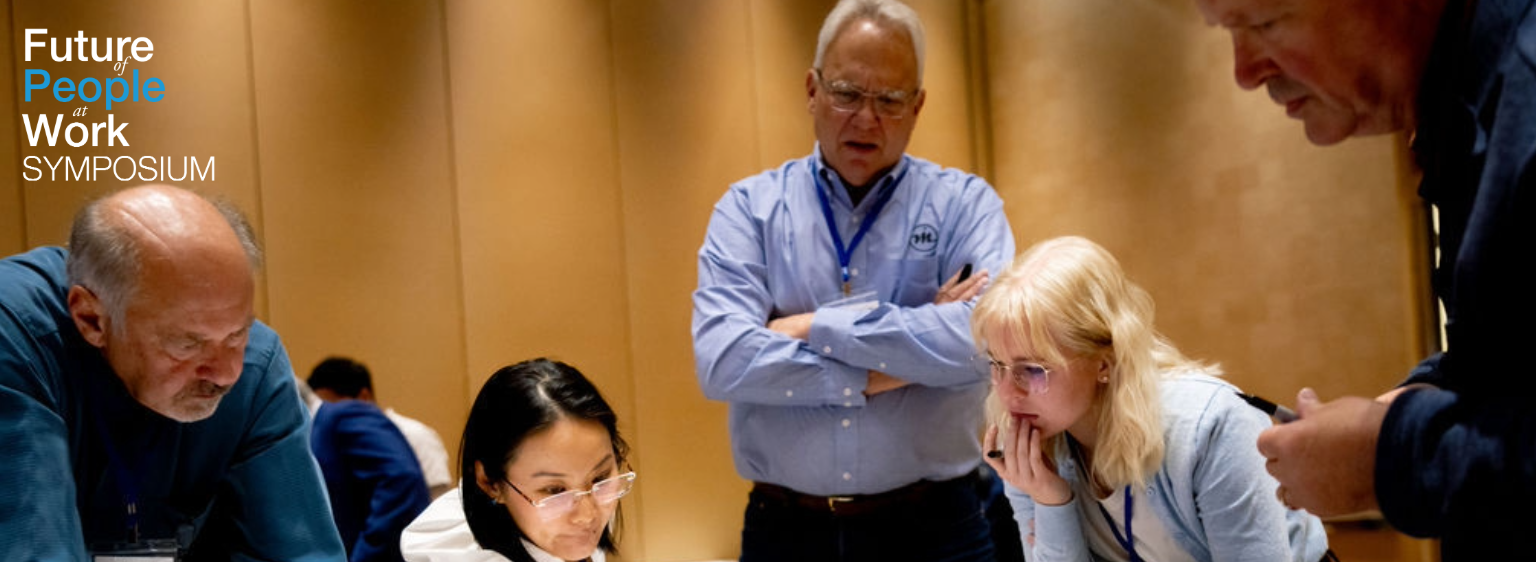By Future of People at Work Symposium Participants and Claude AI*
This article is the fifth in a series exploring the key insights and discussions from the recent Future of People at Work Symposium, a groundbreaking event that brought together the Lean Community to address the pressing challenges facing today’s workplace. Read the first, second, third, and fourth, articles in the series.
As we near the conclusion of our exploration into the Future of People at Work Symposium insights, we turn our attention to a challenge that strikes at the heart of Lean’s future: how to rebrand and reimagine Lean for the next generation. This topic, which emerged as a recurring theme throughout the symposium, sparked passionate discussions about Lean’s image, relevance, and appeal in today’s rapidly changing work environment.
Setting the Stage: The Need for Evolution
The urgency of this topic was underscored by several speakers and participants. As one attendee put it, “Lean has been around for decades, but to many young professionals, it still sounds like something from their grandparents’ era.” This sentiment echoed concerns raised by industry leaders about the need to refresh Lean’s image to attract new talent and maintain its relevance in the age of digital transformation and AI.
Interestingly, while new management trends have come and gone over the years – from Six Sigma to Agile to Design Thinking – Lean has continued to evolve and prove its value. As one participant noted, “Lean’s staying power is a testament to its fundamental principles. Our challenge is to show how these principles apply to today’s challenges.”
The Panel Discussion: Insights from Lean Pioneers
A highlight of the symposium was a panel discussion featuring Lean pioneers Jim Womack, John Shook, and Jeff Liker, moderated by Lisa Yerian, Chief Clinical and Operational Improvement Officer of the Cleveland Clinic. These respected figures in the Lean community offered valuable perspectives on Lean’s evolution and its future.
Jim Womack, renowned Lean author and founder of LEI, emphasized the importance of adapting Lean principles to new contexts. “Lean thinking isn’t static,” Womack argued. “It’s a dynamic approach that can and should evolve to meet new challenges.”
John Shook, former chairman and CEO of LEI, focused on the human element of Lean. “As we reimagine Lean for the next generation, we must remember that at its heart, Lean is about people,” Shook stated. “It’s about empowering individuals to solve problems and create value. That’s a message that resonates across generations.”
Jeff Liker, author of “The Toyota Way,” stressed the importance of maintaining core Lean principles while embracing new technologies. “The fundamental ideas of respect for people and continuous improvement remain as relevant as ever,” Liker noted. “Our challenge is to show how these principles apply in today’s digital workplaces.”
Collaborative Exploration: Lean Coffee Insights
During the Lean Coffee sessions, participants delved into several key aspects of rebranding and reimagining Lean:
- Language and Terminology: Many felt that Lean’s vocabulary needed an update to resonate with younger professionals.
- Digital Integration: Discussions centered on how to incorporate modern digital tools and platforms into Lean practices.
- Purpose-Driven Appeal: Participants emphasized the need to highlight Lean’s potential for positive impact, aligning with younger generations’ desire for meaningful work.
- Education and Training: Ideas were shared on how to introduce Lean concepts earlier in educational pathways and make training more engaging.
One group’s discussion led to a powerful insight: “We need to show that Lean isn’t just about efficiency—it’s about empowerment, innovation, and making a real difference in the world.”
Addressing Misconceptions
A significant part of the rebranding discussion focused on addressing common misconceptions about Lean. Participants identified several key myths that need debunking:
- Lean is only for manufacturing
- Lean is primarily about cost-cutting and job elimination
- Lean stifles creativity and innovation
- Lean is outdated in the digital age
As one attendee noted, “We need to show that Lean is a dynamic, evolving philosophy that’s more relevant than ever in today’s complex, fast-paced world. It’s about problem-solving and attracting top talent who want to make a difference.”
Building on Insights: The 25/10 Crowdsourcing Exercise
The symposium employed a unique ideation technique called the 25/10 crowdsourcing exercise. In this activity, participants rapidly generated and evaluated ideas, resulting in a selection of the most impactful proposals. This exercise generated several bold ideas for rebranding and reimagining Lean:
- Create a “Lean for Good” campaign showcasing Lean’s application to social and environmental challenges.
- Develop a Lean-focused social media strategy, including influencer partnerships and interactive content.
- Launch a “Lean Innovation Lab” where young professionals can apply Lean principles to cutting-edge technologies.
- Establish a “Lean Pioneers” mentorship program connecting experienced practitioners with young professionals.
These ideas demonstrate a collective vision for a more dynamic, inclusive, and purpose-driven Lean movement.
Next Steps and Action Plans
True to Lean principles, participants didn’t stop at idea generation. They outlined concrete steps for moving forward:
- Form a cross-generational working group to develop new ways of communicating Lean concepts that resonate with younger audiences.
- Create a series of case studies and success stories that showcase Lean’s relevance in diverse, modern contexts.
- Collaborate with educational institutions to integrate Lean thinking into curricula, from K-12 through higher education.
- Develop a Lean certification program that incorporates both traditional principles and modern applications.
As one participant enthusiastically stated, “We have an opportunity to reinvent Lean for the 21st century. Let’s make it exciting, relevant, and irresistible to the next generation of problem-solvers.”
The Human Element in Lean’s Evolution
Throughout the discussions, a common thread emerged: while the packaging and presentation of Lean may need to evolve, its core principles of respect for people and continuous improvement remain as relevant as ever.
Looking Ahead: The Future of Lean
The discussions on rebranding and reimagining Lean revealed a community that is both proud of its heritage and eager to evolve. It highlighted the Lean movement’s commitment to self-reflection and continuous improvement, applying its own principles to ensure its ongoing relevance and impact.
In our final article of this series, we’ll explore the unique collaborative process that made the Future of People at Work Symposium so impactful. We’ll examine how the symposium itself embodied Lean principles, fostering innovation and driving action through its interactive format.
Join us next week for the concluding piece in our series, where we’ll unpack the “Collaborative Symposium Process: Driving Conversation to Action.” We’ll explore how this unique approach to knowledge sharing and problem-solving might serve as a model for future Lean gatherings and beyond.
To sign up to be updated or participate in upcoming Future of People at Work activities or events click here.
*This series is the product of a novel collaboration between human insight and artificial intelligence. Content is derived from the collective contributions of the 150 attendees of the Future of People at Work Symposium, processed and structured by Claude.AI 3.5 Sonnet, and curated by Eric O. Olsen Director – Central Coast Lean, one of the Symposium collaborating organizations.
Future of People at Work Symposium
This unique event brings together practitioners, leaders, and thought pioneers to shape the future of work through collaborative problem-solving and shared learning.





It’s clear the lean community is struggling with attracting the younger generation. Share in this frustration. Have given it some though and am starting to think we have a problem with what lean is versus what motivates young and eager people. Long ago many of us had the light bulb moment when we stopped focusing on tools and started understanding principles. Of course this is part of the lean journey and when we start really being lean practitioners. It might also be the marketing problem. Everyone in the lean community seems to like martial arts references so will use martial arts to illustrate. I have trained in martial arts all my life and can be honest about why. When I was a young teenager I had one motivation. Become as good of a fighter as possible. As I entered my 20’s & 30’s I become really interested in different systems and how they address complex situations. Now at the end of my 40’s I still have my preferences in styles but have different goals. Really appreciate the social & health benefits of training. Simply attending class and feeling motivated to keep learning out ways the actual combative abilities. Perhaps I started to truly embrace the martial arts spirit versus the study of combat.
Connecting this together, will highlight the age profile of martial arts schools today in the west. Traditional styles like Karate generally attract children and parents. Often they actual have child parent classes.
Older teenagers and young adult’s mainly train in Brazilian jiu-jitsu, mixed martials or modern combative. Why? They want to learn how to fight and don’t care about the spiritual aspects.
This is my point. We may realize it’s not about tools but it is the tools which they seek. I wrote this because I love lean and want the next generation to benefit as much as we have. My suggestion as odd as it sounds is to create and promote tools which appeal to this generation. Get them in and then we can show them the light.